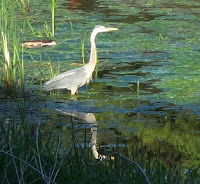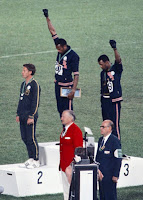Well, the autumnal equinox has been and gone . . . which means the "time of transformation" is well and truly upon us. Indeed, here in Minnesota the leaves are turning and the temperature is cooling. Time, then, to take a look back on the summer that has ever-so-recently ended . . . and a summer that actually included a winter – an Australian winter!
But first, regular readers will be familiar with my "Out and About" series, one that I began in April 2007 as a way of documenting my life as an “out” gay man, seeking to be all “about” the Spirit-inspired work of embodying God’s justice and compassion in the world. I've continued the series in one form or another for the last 10 years – in 2007, 2008, 2009, 2010, 2011, 2012, 2013, 2014, 2015, 2016 . . . and now into 2017.
So let's get started with this latest installment . . .
Above and right: I feel like my summer really got off to a great start with a June 15-17 trip "up north" with my dear friend Kathleen to the Grand Marais on Minnesota's beautiful North Shore.
Over the years I've embarked on many memorable road trips with Kathleen, including to St. Louis in 2008, Wisconsin in 2010, Kansas City in 2012, and Pahá Sápa in 2013.
Above: Grand Marais – Saturday, June 17, 2017. For more images and commentary of our visit to Grand Marais, click here.
Above: Back in the Twin Cities and my home in south Minneapolis.
I'm very fortunate to live where I do and with the best housemate one could possibly ever want. First things first, though, where I live. . . . I'm very close to Minnehaha Creek and its surrounding parkland and areas of urban wilderness. The heron at left, however, was not photographed at the creek but on a pond not far from Cedar Lake, which is also located in Minneapolis. I was house- and cat-sitting for some friends in that area early in the summer. For more images of and around Cedar Lake taken at this time of "perfect young summer," click here.
Above: Now here's a photo that was taken by Minnehaha Creek. In fact, the creek is just out of view over on the right!
Since the end of August I've been walking the path that you can see in this picture every day to catch my bus to work. I feel very connected to the large oak that you can see, for reasons which I talk about here.
Above: Playing badminton with Tim, my housemate, in the front yard of our home. He won!
As I said before, Tim is a great housemate . . . and I feel very fortunate to know him in that way and as a good friend.
Right: Tim and his girlfriend Colleen. We were all out celebrating Tim's birthday at the the end of June.
Above: Speaking of special friends, here's my boyfriend Brent! Among many other wonderful things, he's a big time Wonder Woman fan! We went and saw the new Wonder Woman movie when it first came out in early June. We both liked it a lot (even though, truth be told, the Scarlet Witch is my favorite superhero!).
At the end of June I "moved on" from my site coordinator position with TRUST Meals on Wheels, a position I'd had since June 2011. On Monday, June 26, 2017, my colleagues and friends at TRUST hosted a farewell reception for me.
Above: With my work colleague Julia and a number of Meals on Wheels volunteers. From left: Margie, me, Julia, Kim, Larry, Ann and Dick – Monday, June 26, 2017.
Left: With longtime Meals on Wheels volunteer Sue and little Leo.
For more images and commentary, click here.
On Saturday, July 1, I had a number of friends over for a party ahead of my July 9 departure for Australia for a six-week visit.
Above: Friends Tim, Hugh, David, Omar, Matthew, Brent, and Zac.
Right: Friends Stephanie, Alfredo, and John.
For more commentary and photos of this and other "bon voyage" gatherings at around the same time, click here.
Above: An Australian sunrise – July 24, 2017. It was, of course, winter in the southern hemisphere when I was in Australia.
To start at the beginning of my "Australian Sojourn – Winter 2017" series of posts, click here.
Above: With my two brothers and our parents – Coogee, August 5, 2017.
We gathered in Coogee, a beachside suburb of Sydney, to celebrate my Dad's 80th birthday. For more images and commentary, click here.
Above and below: Feeling at one with the spirit of Guruk.
Above: On August 22 I returned to Minnesota and my home by beautiful Minnehaha Creek in south Minneapolis.
Above: Friends John and George . . .
. . . whose September 16 wedding in Minneapolis I had the great honor of officiating!
Above: Brent and I at George and John's September 16, 2017 wedding ceremony at The Towers in downtown Minneapolis.
Summer 2017 Wild Reed posts of note:
• The Holy Spirit: Giver of Knowledge, Light, Inspiration, and Guidance
• Our Lives as LGBTQI People: “Garments Grown in Love”
• Vanessa Redgrave: “Just Being Alive, Staying Human, I Think That’s Infinitely Precious”
• June, the “Time of Perfect Young Summer”
• Progressive Perspectives on Jeremy Corbyn's Achievement in the UK Election
• He's Back!
• On the First Anniversary of the Pulse Gay Nightclub Massacre, Orlando Martyrs Commemorated in Artist Tony O'Connell's “Triptych for the 49”
• Tony Enos on Understanding the Two Spirit Community
• A Visit to Grand Marais
• Police, Pride, and Philando Castile
• Making the Connections
• Interiors
• Petula Clark: Singing for Us, Not at Us
• Moving On
• Australia Bound
• Ahmad Joudeh: Dancing for Peace
• Buffy Sainte-Marie Headlines SummerStage Festival in NYC's Central Park
• Challenging Discrimination Through a Modern Take on Traditional Dance
• In Charlottesville, the Face of Terrorism In the U.S.
Australian Sojourn – Winter 2017
• A Visit to the Art Gallery of New South Wales
• Overcast Skies
• Austen and Australia
• Donald Trump: A View from Australia
• Return to Guruk
• The Neoliberal Economic Doctrine: A View from Australia
• Guruk Seascapes: From Dawn to Dusk
• Good Mr. Dawes
• A Visit to Sydney's Taronga Zoo
• Journey to the Southern Highlands & Tablelands: Exeter and Mt. Alexandra
• Journey to the Southern Highlands & Tablelands: Bundanoon and the Sunnataram Forest Monastery
• Journey to the Southern Highlands & Tablelands: Goulburn and Canberra
• The State of Marriage Equality in Australia (Part 1)
• The State of Marriage Equality in Australia (Part 2)
• In Coogee, A Very Special Birthday Celebration
• Return to Sydney
• A Visit to Gunnedah
• Last Days in Australia
• Guruk Sunrise
Return to Minnesota . . . and to Summer!
• Worldwide Gay Pride 2017
• Spirituality and the Health Care Setting
• Thank You, Frank!
• The Prayer Tree
See also the previous Wild Reed posts:
• Out and About – Spring 2017
• Out and About – Winter 2016-2017
• Out and About – Autumn 2016
• Out and About – Summer 2016
• Out and About – Spring 2016
Images: Michael J. Bayly.



































































